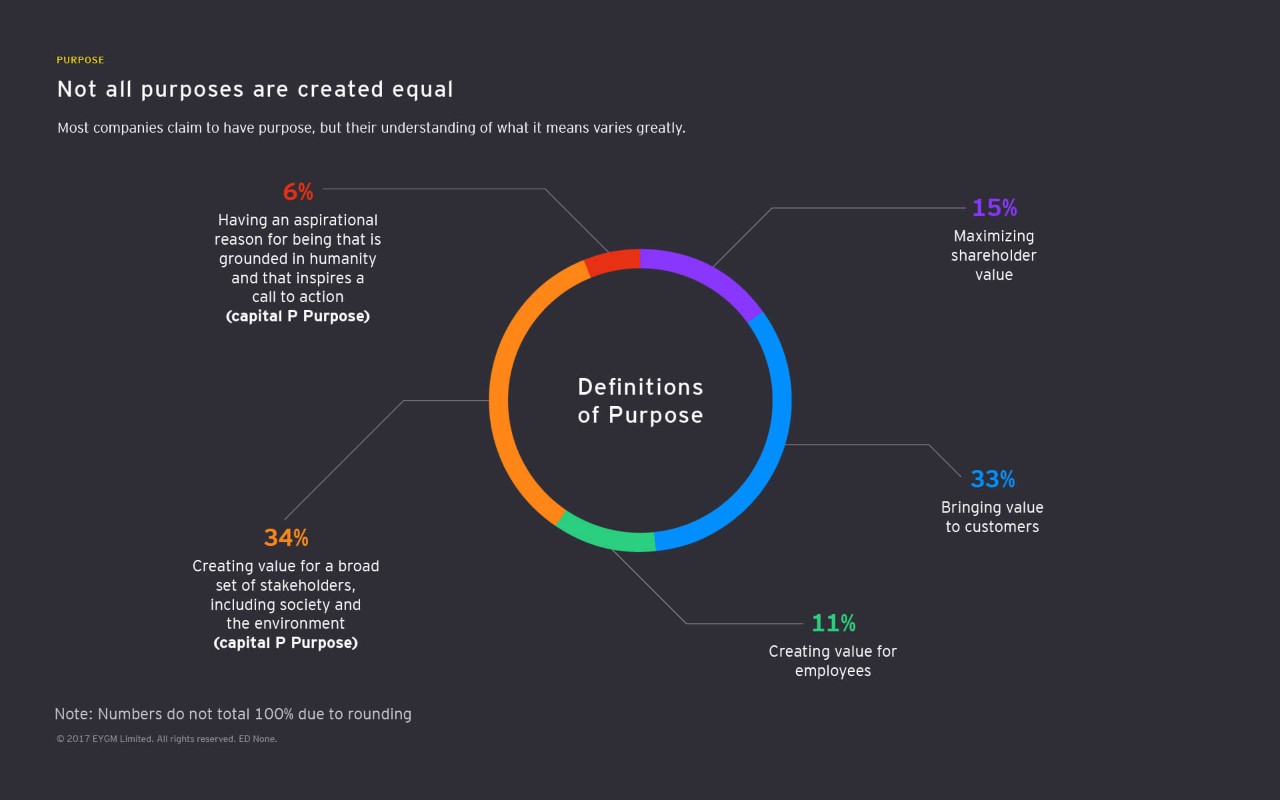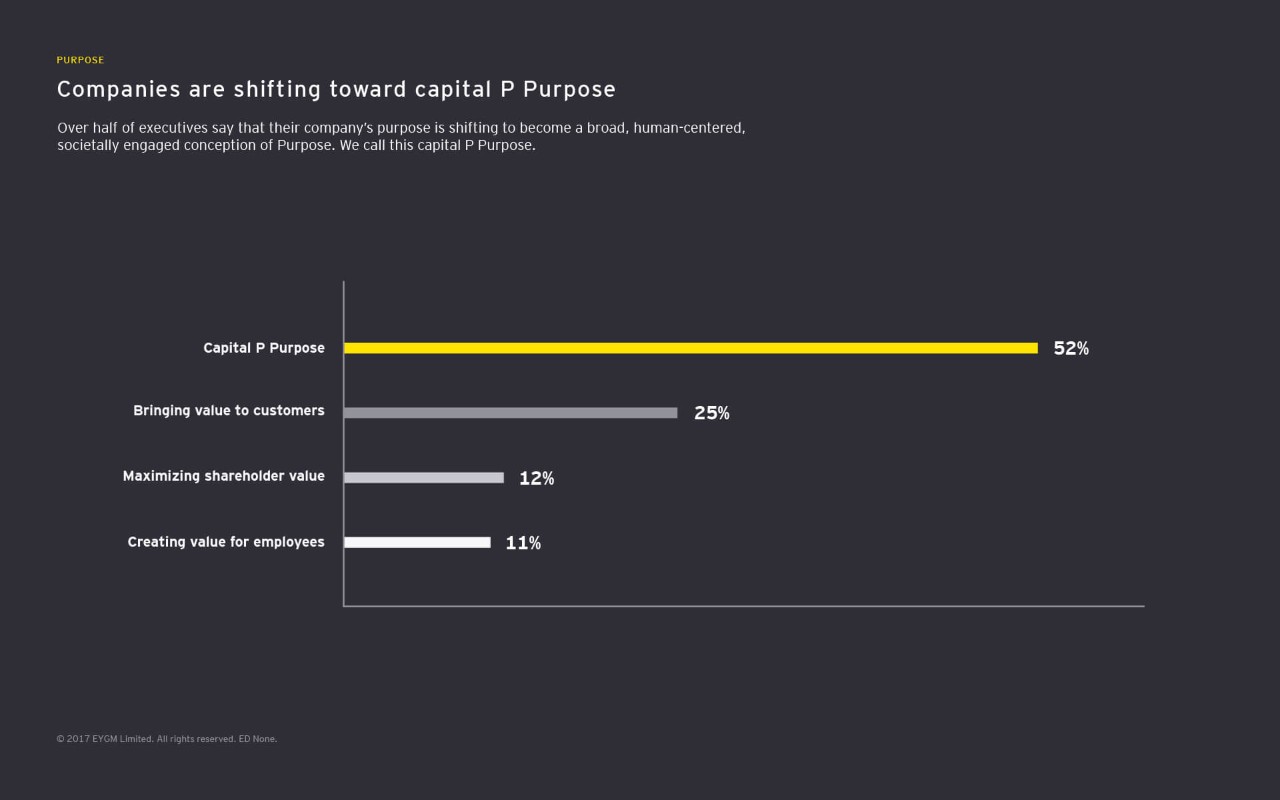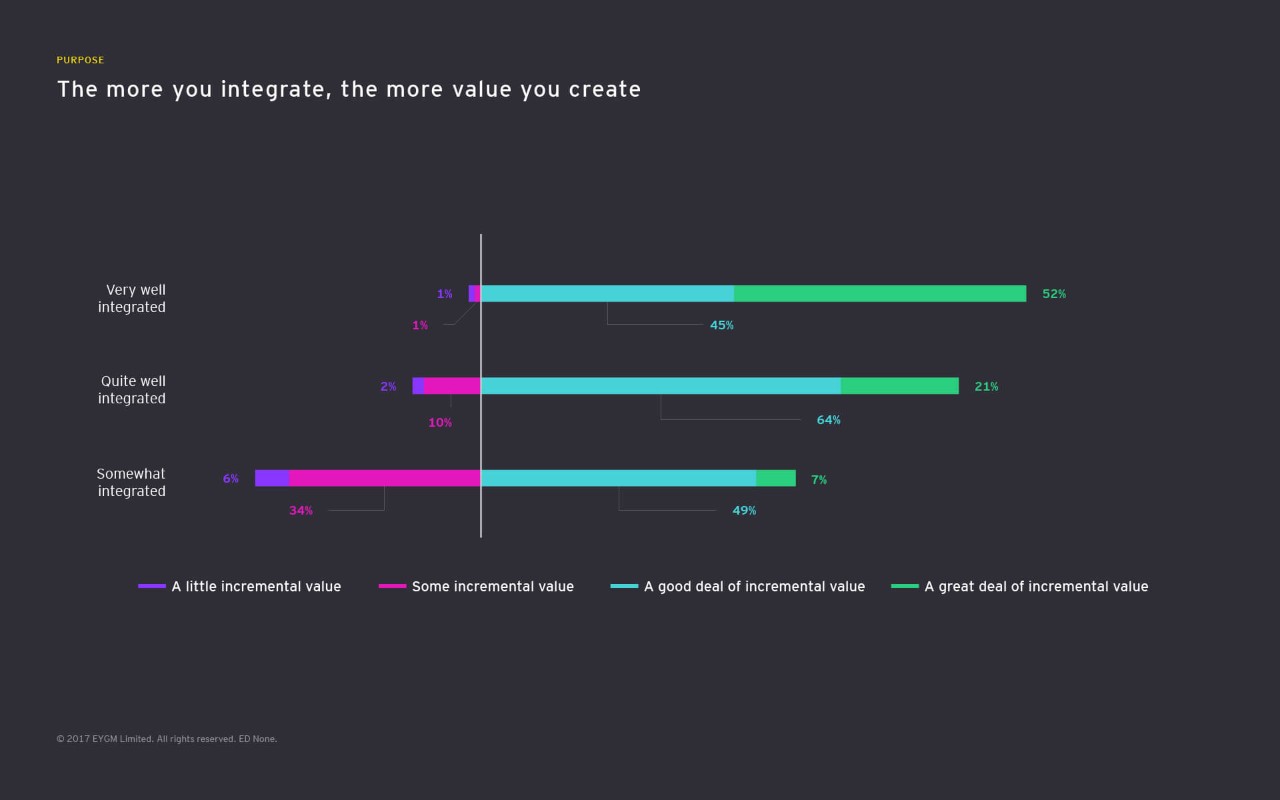How business leaders see purpose
To gain new insight into how purpose can help navigate these volatile, uncertain conditions, EY spoke to 1,470 business leaders from a wide range of industries around the world. The survey revealed how best-in-class purposeful companies are using their purpose as a beacon to navigate turbulent times – as well as how they are embedding their purpose in decisions and daily actions throughout their organizations.
The research yielded some interesting findings:
Not all purposes are created equal
While almost all leaders (95%) say their organization has a purpose, this can mean different things. For some, it means serving a single stakeholder group, whether it be shareholders, employees or customers. The research revealed a significant new group that defines purpose as something greater: a human-centered, socially engaged conception of purpose that seeks to create value for a broad set of stakeholders. EY has labeled this definition as capital P “Purpose.”
Purpose helps companies navigate today’s volatile world
In a world that’s changing faster than ever, and that is more uncertain than ever, purpose acts as a “North Star"," says Mark Weinberger, Global Chairman and CEO, EY. This was evident in our survey of business leaders.
Two-thirds of executives (66%) are profoundly rethinking their purpose as a result of the current disruptive environment, and most of those (52%) are moving towards EY’s definition of capital P Purpose. 73% of business leaders say that having a well-integrated purpose will help their company navigate disruption.
Related article
In a world that’s changing faster than ever, and that is more uncertain than ever, purpose acts as a “North Star".
Having a Purpose doesn’t necessarily make you Purposeful
The right kind of Purpose (with a capital P) is important, but this must be integrated into an organization to fully unlock value. A best-in-class group of “Purposeful companies” stand out for both articulating a Purpose and for making significant progress in driving this into their corporate DNA.
Integrating Purpose brings benefits, but just talking about Purpose – without action – exposes a company to risk
The survey found that Purpose drives value in both the short- and long- term. However, if Purpose is merely words that are not matched by deeds, companies can face negative reputational risk and loss of trust.
Purposeful companies provide insight on how to turn rhetoric into reality
Purposeful companies align their strategy and decision-making with a Purpose that responds to the needs of their stakeholders and is grounded in the heart of what they do. They constantly evaluate where they are in their journey and what needs to change, taking concrete steps to make that happen.
EY’s research found that the best strategy to begin reaping the benefits of Purpose is to engage in the process of integration as quickly and as authentically as possible, and uncovered concrete recommendations that can help leaders understand how to do this.


Chapter 1
Purpose and the 21st century company
Not all purposes are created equal.
Nearly all of the almost 1,500 business leaders we surveyed claimed their company has a purpose of some sort. Yet while the word purpose is heard increasingly often when senior executives speak, it is used to mean very different things — and not all purposes are created equal.
For this survey, we went beyond previous studies by analyzing the extent and impact of different characterizations of purpose. The research focused on five definitions of purpose:
- Maximizing shareholder value
- Primarily creating value for customers
- Primarily benefiting employees
- Serving a broad set of stakeholders including society
- Having an aspirational, human-centric reason for being
While some 60% of executives described their company’s purpose as focused on serving the interests of a single stakeholder, only 15% say that this stakeholder is the shareholder. This seems to be a clear rejection of what was perceived as the dominant paradigm in business until the 2008 financial crash.
More importantly, our research reveals that there is a type of company that is doing better than the rest in surviving and thriving in today’s turbulent and unpredictable global economy. They are the Purposeful companies that embrace a humanistic, multi-stakeholder oriented Purpose and that fully align all that they do in order to pursue it.
The disrupted world is causing a rethink of purpose…
A volatile, uncertain economic landscape has prompted some fundamental rethinking within many companies about the how and the why of their business. Two out of three of the business leaders surveyed said that the onset of this new era of heightened economic volatility has led their company to make significant changes in its corporate purpose.
…and the direction of travel is clear
The survey also makes clear how attitudes are changing among global business leaders.
More than half (52%) of the executives who are reconsidering their purpose, including many who currently describe their company as having a purpose focused on a single category of stakeholder, say that their company is moving in the direction of serving multiple stakeholders and society.
In other words, they are starting to move from purpose to Purpose.
Capital P Purpose
Over half of executives say that their company's purpose is shifting to become a broad, human-centered, societally-engaged conception of Purpose. We call this capital P Purpose.
Of the respondents in our survey with a capital P Purpose, 21% say it is very well-integrated. These are the truly Purposeful companies.


Purposeful companies outperform the rest
Companies that have embedded Purpose most thoroughly also report the highest incremental value creation from that integration.
While 97% of companies with a “very well-integrated” Purpose see a good or great deal of incremental value from that Purpose, only 56% of those with a “somewhat well-integrated” Purpose achieve the same level of value.
This is not merely an expression of faith that their actions will pay off sometime in the future. A strong majority of executives of Purposeful companies — 75% — said that the integration of Purpose creates value in the short term, as well as over the long run.
How Purpose creates value
Executives from Purposeful companies identified several overarching ways in which the pursuit of Purpose drives value. Those most frequently cited are of obvious benefit in today’s volatile, uncertain economy: giving companies the agility to innovate in times of disruption and the ability to drive transformational change. In fact, 73% of executives agree that having a well-integrated purpose helps their company navigate today’s turbulent environment.
At a more granular level, the executives identified some specific ways in which embedding the pursuit of Purpose in all that they do creates value:
- Building greater customer loyalty
- Preserving brand value and reputation
- Attracting and retaining top talent
- Developing innovative new products and services
Executives from different industries say that their pursuit of Purpose delivers the greatest value in areas that arguably are most critical to them:
- Those in the life sciences and diversified industrial products industries, for example, state that Purpose drives value by helping to develop innovative new products.
- Consumer products organizations see Purpose as most fundamental in building greater customer loyalty.
- In oil and gas and in mining and metals, Purpose provides most value in helping companies identify and mitigate risks.

Chapter 2
The journey from rhetoric to reality
Few executives think their company has gone far enough in its Purpose journey to create significant value.
While many leading organizations understand the power of purpose, they find integrating purpose into their strategy and realizing its full value much more challenging.
Though there is a sharp increase in the number of executives talking about Purpose, relatively few think their company has gone far enough in its Purpose journey to create significant value. Huge opportunities remain for companies willing to set off on this road less travelled.
Our survey asked business leaders to rate the criticality of 37 different factors for integrating purpose into their organization. Purposeful companies identified almost twice as many of these factors as critical compared with companies that are serving a single stakeholder. In other words, these best-in-class companies have a much deeper and broader understanding of the actions needed for Purpose to become part of the corporate DNA.
Purposeful companies are more integrated than their peers across all of the factors deemed critical, yet even they admit to falling short on some of these crucial issues, saying they still have a way to go in integrating purpose into decision-making and putting it at the heart of the corporate culture.
Executives at companies that have embraced but not yet integrated Purpose claimed only modest progress in general and identified a smaller number of areas as critical than did their peers at Purposeful companies.
This suggests that these companies may be at risk of one of the greatest pitfalls along the purpose journey: treating their purpose as a marketing-led activity.
Integrating purpose requires commitment
The Purpose Integration Curve is inferred from the answers given by the executives we surveyed. It suggests that the moment of greatest danger for a company, when the most value is at risk, is when there is a big gap between what stakeholders expect of the firm and the reality of its actions.
This is especially likely to occur in the early phase of articulating a Purpose, when the expectations have been raised, but the process of embedding the pursuit of Purpose in all that the company does has barely started. Companies must demonstrate commitment through a willingness to transform aspects of their business and even sacrifice parts of their operations that are not aligned with being Purposeful.
Related article

Chapter 3
How to turn purpose rhetoric to reality
Four phases to becoming purpose-led.
While every company is different, and will need to find its own path to purpose, our research identified a number of phases and distinct actions that best-in-class companies typically cross on their journey to becoming Purposeful:
1. Articulate purpose:
- Define a clear purpose for your organization, before others do it for you
- Be ambitious and inspiring, yet grounded in the reality of what you can deliver
- Convey your purpose in terms of the long-term value created for the people you serve
- Communicate success stories to key constituents
2. Embed the pursuit of purpose:
- Develop an integration plan and commit to deliver on it
- Focus where it matters most — at the commercial front line
- Use purpose as a lens for making decisions
- Close the gap between what the company says and does
3. Evaluate Progress:
- Practice radical candor, challenging the extent to which purpose governs strategic decisions and daily actions
- Take stock of setbacks as well as acknowledge successes
4. Accelerate the journey:
- Have senior leadership champion purpose and demonstrate their commitment through their words and actions
- Liberate and incentivize middle managers to act in the interest of purpose
- Make purpose integral to employees’ day-to-day experiences
- Measure and reward decisions and behaviors that align to purpose
“The main challenge we see companies grappling with is not understanding what their purpose should be – it’s understanding how to make it real," says Karin Lutz, Global Leader, Women. Fast Forward, EY. "Purpose is at its most powerful when it guides decision-making at all levels in the organization.”
Purpose in the 21st Century
Our research found that being a Purposeful company is the key to succeeding in the turbulent, unpredictable economy of the 21st century.
Yet while many executives are happy nowadays to use the word purpose, the great majority have yet to move from rhetoric to the reality of what it takes to be truly Purposeful.
Purposeful companies have a Purpose that represents the company’s energizing, inspirational story.
It describes its aspirations and inspires its people to pursue them.
It seeks to serve all its stakeholders and aspire to build a better world.
This is what EY has dubbed capital P Purpose.
But it is not enough to simply embrace Purpose. Purposeful companies recognize that they must embed this Purpose in all that they do, from their strategy and business model to how they manage and incentivize their employees and engage with other stakeholders. Those that do reap the short- and long-term benefits that Purpose affords.
For business leaders looking for the best way to survive and thrive in the face of today’s forces of disruption, the message is clear: begin your Purpose journey without delay.
Summary
Businesses need to embrace and integrate a humanistic, multi-stakeholder oriented purpose to navigate today’s volatile, uncertain economy.

